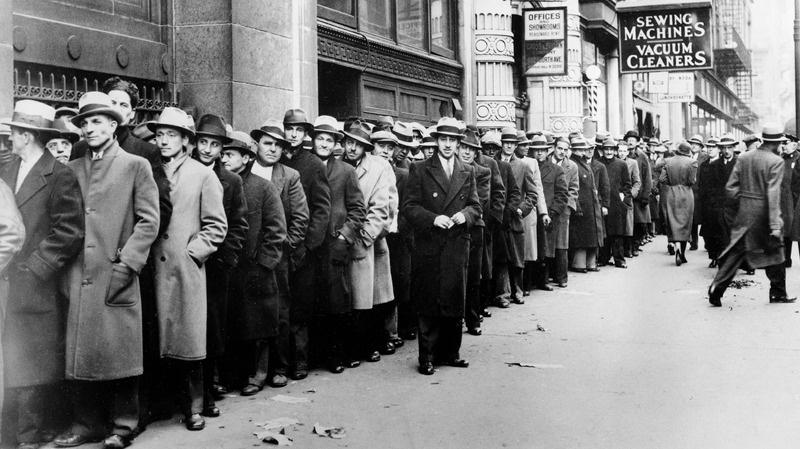
4 minute read
The Great Depression: Reshaping the Economic Landscape
The Great Depression, a severe worldwide economic downturn in the 1930s, had a profound and enduring impact on the global economy Its repercussions reshaped economic policies, financial systems, international trade, and social welfare programs worldwide. What happened in the 1920s in the United States and worldwide?
The Great Depression began with the stock market crash on October 29, 1929, known as "Black Tuesday." Speculation and excessive borrowing had driven stock prices to unsustainable levels, leading to a sudden collapse in stock values The crash shattered investor confidence and triggered a chain reaction of economic problems. The stock market crash caused a sharp decline in consumer spending and business investment. This, coupled with a reduction in international trade, led to a contraction in economic activity Businesses faced declining profits and were forced to cut production and lay off workers, leading to widespread unemployment. The financial sector suffered significant losses during the Great Depression. Many banks had invested heavily in the stock market and experienced substantial losses when the market crashed. As a result, numerous banks collapsed, eroding public confidence in the banking system This further exacerbated the economic downturn as people lost their savings and credit froze. The overproduction of goods during the 1920s, particularly in the agricultural and manufacturing sectors, led to excess supply. However, with declining incomes and widespread unemployment, people needed more purchasing power, resulting in under-consumption. This created a reduced production cycle, further layoffs, and decreased demand. The Great Depression was not limited to the United States; it had a global impact Countries relied heavily on international trade, and when the U S economy faltered, it led to a decline in global trade. Protectionist measures, such as tariffs and trade barriers, worsened the situation by reducing international commerce and exacerbating economic difficulties
Advertisement
It had profound social consequences Unemployment rates soared, poverty levels rose, and people faced extreme hardships. Homelessness, hunger, and destitution became widespread. Many individuals and families lost their homes and were forced into makeshift shantytowns, while others relied on government relief programs or charitable assistance.
The current global economy has a lot to learn from the great depression; some of the major learnings were-
Ø Interconnectedness: The current global economy is distinguished by unprecedented interconnectedness across nations The Great Depression emphasized the dangers of isolationism and protectionist policies, prompting a shift towards more international collaboration and commerce. Countries see the value of interconnection and work to achieve global economic stability through organizations such as the World Trade Organisation (WTO) and regional trade agreements.

Ø Keynesian Economics: The Great Depression also influenced economic thought and paved the way for the rise of Keynesian economics British economist John Maynard Keynes argued that during times of economic downturn, governments should increase spending to stimulate demand and counteract recessions. This idea shaped economic policies in subsequent decades and contributed to accepting fiscal stimulus as a tool to manage economic fluctuations.
Ø Government Intervention and Regulation: The Great Depression exposed the limitations of laissez-faire economics and precipitated a paradigm shift towards more government intervention. Governments increasingly take a more active role in economic management, enacting fiscal and monetary policies to stabilize and boost development Financial institution regulations and consumer protection have been improved to avoid a repetition of the 1930s financial catastrophe.
Ø Global Financial Institutions: The Great Depression exposed flaws in the international financial system and led to the establishment of global financial institutions to promote stability and cooperation. The International Monetary Fund (IMF) and the World Bank were created after the Great Depression to provide financial assistance, facilitate international monetary collaboration, and support economic development. These institutions continue to play a significant role in the present world economy.
Ø Trade and Protectionism: The Great Depression triggered a wave of protectionist measures as countries sought to safeguard their domestic industries and protect jobs. However, the negative consequences of this approach became apparent, leading to a recognition of the benefits of international trade and economic cooperation Over time, efforts were made to reduce trade barriers, forming institutions like the World Trade Organization (WTO) and the proliferation of regional trade agreements. These developments shaped the present global trade landscape.
Ø Macroeconomic Management: The Great Depression highlighted the importance of macroeconomic management and the need for governments to use monetary and fiscal policies to stabilize economies actively. Central banks and governments now closely monitor economic indicators, implement counter-cyclical measures, and adjust interest rates and taxation to manage economic fluctuations. This approach to macroeconomic management, influenced by the lessons of the Great Depression, remains a crucial aspect of the present world economy.
Ø Social Welfare and Safety Nets: The Great Depression's hardship and social instability prompted the foundation of social assistance programs Governments established safety nets, unemployment programs, and healthcare systems to safeguard residents during economic downturns. These programs seek to eliminate inequality and assist those in need, contributing to social stability
Ø Global Financial Institutions: The Great Depression exposed the vulnerabilities of the global financial system. In response, international financial institutions such as the International Monetary Fund (IMF) and the World Bank were created to provide financial stability, promote economic development, and assist countries in times of crisis. These institutions serve as vital pillars of the present global economic architecture.
Ø Technological Advancements and Globalization: Technological advancements have significantly transformed the present global economy. Innovations in communication, transportation, and manufacturing have facilitated the rapid expansion of worldwide trade and the integration of markets. Information and communication technologies have allowed businesses to operate across borders more efficiently, promoting globalization and economic growth

The Great Depression is a stark reminder of the dangers of unregulated markets, excessive speculation, and income inequality Governments and central banks now employ macroeconomic policies to mitigate these risks and maintain stability. The importance of international cooperation, sound regulation, and financial safeguards has been ingrained in the global economic framework
Author: Vishal Verma








